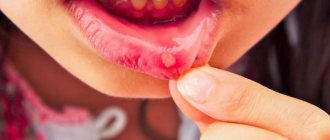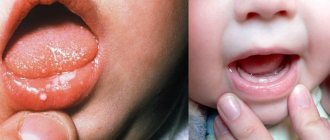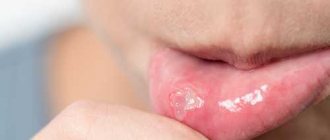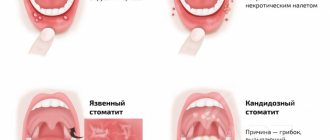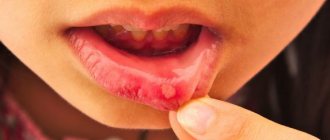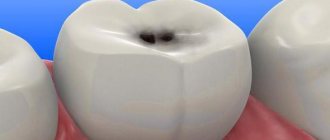Causes of stomatitis
Inflammation of the oral mucosa can be caused by various reasons.
- Mucosal injury6.
- Viral, bacterial or fungal infection6.
- Allergy2.
- Immunity disorders (autoallergy, that is, a reaction to one’s own altered tissues2).
- Diseases of the blood, digestive, cardiovascular, nervous and endocrine systems2.
- Hypovitaminosis - lack of vitamins C, B1, B12, E, D32.
- Common infectious processes: measles, rubella, scarlet fever and diphtheria, infectious mononucleosis, tuberculosis and others1.
Only a specialist can understand the causes of stomatitis. Therefore, if symptoms of the disease appear, you should definitely contact your dentist.
Inflammatory diseases of the oral cavity can occur in a child of any age6. Immaturity of the body is the primary factor predisposing to the occurrence of stomatitis in children under one year of age. The mucous membrane of the oral cavity during this period of a child’s life is very vulnerable, its natural protective properties are reduced. The immunity received from the mother during fetal development and which protected the baby immediately after birth weakens every day. Therefore, the infection easily penetrates the mucous membrane and causes its inflammation. Most often at this age, candidal stomatitis occurs, commonly called thrush1,6.
From the age of one to 3 years, children actively develop immune mechanisms to protect the oral mucosa (local immunity), but its permeability to viruses remains extremely high. Therefore, in a 2-3 year old child, stomatitis is more likely to be viral, in the vast majority of cases - herpetic1,3,4.
From 4 to 12 years of age, stomatitis in children is more often caused by allergic and autoimmune reactions. In particular, chronic aphthous forms of the disease occur during this period1.
Up to contents
“Mom, my mouth hurts!” We talk about stomatitis in children
Is your child being capricious, refusing food, or complaining of pain in the mouth? One of the reasons for this condition may be stomatitis. Alla Aleksandrovna Zmanovskaya, a dentist at Clinic Expert in Irkutsk, told us about the signs of stomatitis in children, methods of diagnosing and treating it.
— Alla Alexandrovna, what is stomatitis?
This is an inflammation of the mucous membrane of any part of the oral cavity - lips, cheeks, tongue, palate, gums.
— Why does stomatitis occur in children?
One of the reasons for the development of stomatitis may be damage to the mucous membrane as a result of mechanical and chemical trauma. There are frequent cases of injury to the mucous membrane by sharp edges of teeth. One type of stomatitis, Bednar's aphthae, develops due to trauma to the oral cavity from a rough pacifier. The availability of household chemicals to a child can cause a chemical burn to the oral cavity.
Viral, bacterial and fungal stomatitis develop against the background of infection with pathogens of ARVI, influenza, herpes, measles, rubella, specific infections (tuberculosis, syphilis, etc.), with weakened immunity, with pathology of certain organs and systems, in particular the gastrointestinal tract , as well as for allergic reactions. Fungal stomatitis can develop due to the use of antibiotics.
— Tell us about the existing types of stomatitis in children and their differences
There are acute and chronic forms of this pathological process. Depending on the elements of tissue damage, catarrhal, ulcerative and aphthous stomatitis are distinguished. They differ from each other both in symptoms and severity, and in treatment tactics.
Acute herpetic stomatitis is a common type of disease in children aged 6 months to 3 years. During this period, children lose antibodies received from the mother while the fetus is in the womb, and their own immunity is not yet ready for an adequate response. With age, there is a decrease in the incidence of this form of stomatitis due to the development of acquired immunity after suffering various forms of herpetic infection.
Infants and children who have undergone long-term antibiotic therapy often develop candidal stomatitis.
— What are the symptoms of stomatitis in children?
Parents may notice rashes on the oral mucosa - blisters, spots, ulcers, erosions, and feel bad breath. Young children become more capricious and refuse foods that especially irritate the inflamed mucous membrane (sour, salty). An older child usually points to the place where it hurts. With more severe stomatitis in children, body temperature may increase. Detection of these signs is a good reason to immediately contact a pediatric dentist.
— What is the diagnosis of stomatitis in children based on?
To make a diagnosis, we first talk with the adults accompanying the child - we find out the complaints, clarify when and how the disease began, how long it has lasted, and what chronic pathologies the child suffers from. Then we move on to examining the oral cavity, recording all changes in the mucous membrane and teeth. An external examination of the maxillofacial area is also carried out. In severe cases of some types of stomatitis in children, rashes on the lips and enlarged regional lymph nodes can be detected.
— What methods of treating stomatitis in children are currently relevant?
Depending on the severity of the disease, local or complex treatment is used. For example, in the case of the development of stomatitis as a result of mechanical damage, it is sufficient to eliminate the action of the causative factor (avoid the use of rough nipples, grind off sharp edges of teeth, etc.), antiseptic treatment of the oral cavity and the use of drugs for regeneration of the mucous membrane against the background of complete sanitation and elimination of the damaging factor a. For chemical burns, depending on the severity, hospitalization is indicated.
For viral, bacterial and fungal stomatitis of moderate and severe severity, in addition to local treatment, antiviral, antifungal or antibacterial therapy is additionally prescribed.
For any form of stomatitis, children should limit their consumption of coarse, hard, irritating foods.
Based on how long it takes for a child’s stomatitis to go away, we can draw a conclusion about the effectiveness of the treatment used and, if necessary, adjust it. Any form of stomatitis is cured within one to two weeks. However, it should be remembered that a feature of stomatitis in an HIV-infected child is that its course, even with appropriate treatment, is delayed for more than 2 weeks.
— Alla Alexandrovna, is it possible to prevent the development of stomatitis?
Can. The main method of prevention is sanitation of the oral cavity, which involves treatment of all teeth affected by caries and its complications, regular thorough oral hygiene, disinfection of premises, household items, and toys.
If a child often has stomatitis, you should consult a dentist and pediatrician, who, if necessary, will prescribe a comprehensive examination. It is important that children receive a nutritious, balanced diet and spend a lot of time outdoors. Hardening the body and playing sports also help the body resist infections.
If you suspect or detect signs of stomatitis in a child, I recommend that you contact a pediatric dentist. By eliminating possible causes and choosing the right therapy, the doctor will be able to prevent oral inflammation from becoming chronic.
For reference:
Zmanovskaya Alla Alexandrovna
In 2015 she graduated from the Faculty of Dentistry of Irkutsk State Medical University.
In 2016, she completed her internship at the Federal State Budgetary Educational Institution ISMU in the specialty “General Dentistry”.
In 2016, she underwent professional retraining at the Federal State Budgetary Educational Institution ISMU in the specialty “Therapeutic Dentistry”, in 2022 – in the specialty “Pediatric Dentistry”.
Dentist-therapist, pediatric dentist at “Clinic Expert” Irkutsk. Receives at the address: Irkutsk st. Kozhova, 9a
Traumatic stomatitis
Inflammation of the mucous membrane in the mouth can be preceded by trauma: mechanical, thermal, chemical, radiation1,6.
Small children who put everything in their mouths can injure the mucous membranes with the sharp edges of toys or household items. Injuries often occur due to inept use of cutlery as a result of falls. In older children, stomatitis may be associated with a thermal burn, blows to the teeth, or the bad habit of chewing a pencil or pen. Sometimes the cause of inflammation is dental diseases and their treatment: sharp edges of damaged teeth and fillings, braces and aligners1.
When stomatitis develops in a child on the gum, on the inner surface of the cheek or in another place, the mucous membrane becomes red and swollen, and a painful erosion or ulcer may appear in the area of damage. Since there are many microorganisms in the mouth, there is always a risk of a bacterial or fungal infection1.
If the mucous membrane is constantly injured, painless whitish or whitish-gray layers may form on it.
In children under 1 year of age, stomatitis can be the result of using the wrong nipples: long, tight, irregularly shaped. The resulting Bednar aphthae are located in the area of the transition of the soft palate to the hard palate and are round erosions or ulcers1.
Treatment of traumatic stomatitis in children includes:
- elimination of traumatic factors;
- rinsing the mouth, irrigating the mucous membranes and treating wounds with drugs with an analgesic and antiseptic effect1.
Up to contents
What is stomatitis and what types exist?
The name of the disease indicates its exact location; translated from Latin “stoma” means mouth. Stomatitis is an inflammatory lesion of the oral mucosa (most often ulcerative). Both adults and children can get sick. But the disease affects children more often. This is due to the fact that the mucous membrane at this age is easily infected by pathogenic microflora, because the child’s body is not yet perfect, local and general protective reactions are not sufficiently developed. Statistics show that almost 80% of young children have suffered from this disease at least once.
Stomatitis is the general name for a whole group of diseases of the oral mucosa. Therefore, each of them has its own symptoms and its own treatment methods. Depending on the etiology, stomatitis is divided into several types:
- viral, including herpes - has a viral nature, infection occurs by airborne droplets. The virus can exist on objects (clothing, toys, etc.) for some time. The initial symptoms are similar to those of ARVI: lethargy, fever, runny nose, cough (not always). On the second or third day, light ulcers with a red border appear on the tongue, mucous membranes of the cheeks and lips;
- traumatic - inflammation is provoked by mechanical damage to the inner surface of the mouth, for example, a burn from a hot drink or food, a scratch from a toy stuck in the mouth, biting if the child has an incorrect bite;
- allergic – the inflammatory process is provoked by the entry into the body of a substance that causes an allergic reaction. Most often caused by drugs;
- candidiasis (fungal) - begins when the mucous membrane is infected with the fungus Candida (“thrush”). A striking symptom is a dense white coating on the tongue.
Viral stomatitis
About 80% of all stomatitis in children is caused by herpes viruses3,5. In approximately 70% of cases, the disease develops in children aged 1 to 3 years3,4.
The disease can occur in mild, moderate and severe forms.
With mild herpetic stomatitis, the general condition is practically not disturbed. Body temperature does not exceed 37-37.50 C. Symptoms of inflammation are limited to swelling of the gums and usually the simultaneous appearance of single painful herpetic blisters and erosions on the mucous membrane (no more than 6). After 1-2 days, the contours of the lesions are blurred, the rashes turn pale, and the erosions heal without scarring3.
With moderate stomatitis, the child’s temperature reaches 38-390 C and lasts until rashes continue to appear. General intoxication manifests itself in the form of weakness, headache, nausea. The child becomes capricious, lethargic, refuses to eat and play3.
As the temperature rises, the oral mucosa becomes red and swollen, and the gums begin to bleed. The number of herpetic elements reaches 20-25, repeated rashes are accompanied by fever3.
Severe stomatitis in children looks like a common acute infectious disease and is accompanied by severe intoxication: fever 39-400 C, chills, headache, aching muscles and joints, heart rhythm disturbances, nosebleeds, nausea and vomiting. The number of herpetic elements can reach 100; they are located not only in the mouth, but also on the skin of the face, on the eyelids and conjunctiva of the eyes, and earlobes. In addition, upper respiratory tract symptoms may be present.3
Treatment includes treating the affected area with painkillers and antiseptic drugs, antiviral therapy, drinking plenty of fluids, a balanced diet and proper nutrition3,5.
Up to contents
Main symptoms and signs of the disease
Acute herpetic stomatitis in children develops gradually and is preceded by an incubation period lasting from two days to 3 weeks.
Early symptoms of the disease are:
- burning in the mouth;
- increased salivation;
- headache, nausea, general weakness;
- increased body temperature;
- enlargement of the submandibular lymph nodes;
- the appearance of bad breath.
«
If the parents do not respond to the first signs, after a few days the mucous membrane becomes covered with multiple rashes. Small painful blisters itch, respond with acute pain to the touch, and when they rupture, a cloudy liquid flows out of them. The rash appears on the baby’s gums, cheeks, tongue, lips, and wings of the nose.
Herpes stomatitis can affect not only a school-age child, but also an infant.
The mild form of the disease can be easily treated at home; in moderate and severe forms, hospitalization of the small patient is indicated.
Candidal stomatitis
In 80% of healthy children, Candida fungi can be found in the oral cavity. They get there during childbirth, from nipples and pacifiers, from care products, in contact with the mother's skin, with food during eating and usually do not cause any problems. Candidal stomatitis, or thrush, occurs when immunity decreases1.
Predispose to the disease:
- prematurity and postmaturity;
- developmental defects and concomitant diseases;
- treatment with antibiotics and hormones;
- artificial feeding;
- poor care and poor feeding hygiene;
- Using the wrong nipples1.
What does candidal stomatitis look like? In children's mouths, whitish or whitish-gray dotted formations appear on the reddened mucous membrane. They merge into films of a cheesy nature; when the films are rejected, bright red painful erosions are formed. Because of the pain, the baby becomes restless, cries often, sleeps poorly, and refuses to eat1.
In severe cases of candidiasis, a cheesy coating may appear on the palate and on the lateral surfaces of the tongue, on the tonsils and the back wall of the pharynx - candidal tonsillitis and pharyngitis develop1.
If your child has a fungal infection, you should always consult a doctor; he will tell you how and what to treat the mucous membrane with candidal stomatitis, so that the child does not have complications and recovers faster. Treatment, as a rule, involves treating the oral cavity with drugs with antifungal activity (chlorhexidine, hexethidine). In severe cases of the disease, antifungal agents, probiotics and immunomodulators are prescribed1.
Up to contents
Allergic stomatitis
Allergic damage to the mucous membrane most often occurs in the form of contact stomatitis and chronic aphthous form of the disease1.
Allergens can include medications, food products, varnishes and paints that coat toys, toothpastes, mouth rinses, chewing gum, and dental metals included in braces1,2.
With allergic stomatitis in children, erosions and ulcers may appear in the mouth, but more often the matter is limited to redness and swelling of the mucous membrane1.
Treatment is avoiding contact with the allergen, rinsing or irrigating the mouth with antiseptic solutions to prevent infection. If necessary, doctors recommend taking antihistamines1,2.
Chronic recurrent aphthous stomatitis often occurs in schoolchildren and adolescents due to allergies2. In addition, its development can be provoked by diseases of the gastrointestinal tract, upper respiratory tract infections, disorders of the nervous system, and hypovitaminosis1,2.
With aphthous stomatitis in children, itching and burning first appear in the oral cavity. The mucous membrane at the site of the lesion becomes red and swollen, then an aphtha forms on it - a round or oval erosion 0.5-1 cm in diameter rising above the surrounding tissues with a red rim along the periphery and a bottom covered with a grayish-white coating. Aphthae are extremely painful, and if many of them form, they cause significant distress to the child1,2.
How many days does aphthous stomatitis last in children? With a mild course of the disease, the elements of inflammation persist for up to 5-7 days, then they heal without scar formation2 and do not appear for quite a long time. However, in severe cases, aphthae can occur constantly, and then many elements of inflammation can be found on the mucosa at different stages of development1,2.
To treat aphthous stomatitis, doctors use:
- antihistamines;
- immunomodulatory drugs;
- vitamins;
- probiotics2.
As a local therapy, it is recommended to treat the mucous membrane with drugs with analgesic, antiseptic, proteolytic (protein-breaking), anti-inflammatory and regenerating effects2.
Up to contents
Medicines for stomatitis in children: how to treat?
Selecting the right children's medicine for the medical treatment of stomatitis is a rather delicate process. After all, at different ages, children need to be treated differently: those drugs that are suitable for a one-month-old baby may not affect the course of the inflammatory process at all in a two-year-old child.
The same applies to the question of how long it is necessary to treat such a pathology. In infants, a one-year-old baby and a 2-year-old child, recovery times will also differ, even when using the same remedy. In any case, you should not expect quick treatment, since it takes several days to several weeks to relieve inflammatory reactions and heal damaged tissues.
Drug treatment
Drug treatment is aimed at relieving symptoms of stomatitis such as pain and inflammation, as well as accelerating the healing process of damaged tissue.
Painkillers
Since young children have a fairly low pain threshold, pain relief is the primary goal in the treatment of acute stomatitis. For this purpose, both system-wide drugs for oral administration and local agents in the form of gels are used.
Painkillers for oral administration:
- Ibuprofen is a strong drug that has a pronounced analgesic, anti-inflammatory and antipyretic effect. Its dosage is prescribed at the rate of up to 10 mg per kg of the child’s weight three times a day for no more than 5 days in a row. Can be used no earlier than 3 months of age.
- Paracetamol also relieves pain and fights high fever. For children under three years of age, it is preferable to use rectal suppositories or syrup, while older children can use tablets. The dosage is calculated based on the child’s weight (15 mg per kilogram). It is possible to use the product 3-4 times a day.
Local anesthetics:
- Cholisal is a drug with a good analgesic effect, which additionally has anti-inflammatory and antibacterial effects. Apply the gel to damaged mucous membranes 3-4 times a day before or after meals, as well as before bed. It is not advisable to use before 9 months of age.
- Kamistad - a combination of lidocaine with chamomile infusion gives a good analgesic and anti-inflammatory effect. The gel should be used 3-4 times a day, rubbing it into the area of inflammation.
- Kalgel is a combined drug in the form of a gel with antimicrobial and analgesic effects. Well relieves pain from stomatitis, gingivitis and other inflammatory diseases in the oral cavity. Use no more than 6 times a day.
Antiseptic and anti-inflammatory agents
Drugs with antiseptic properties suppress the activity of pathogenic microorganisms and have a good anti-inflammatory effect. They can be used both for rinsing the entire oral cavity and for treating individual areas of damaged oral mucosa. They are successfully used to treat stomatitis at home.
Sprays for the treatment of stomatitis:
- Hexoral is a spray with pronounced activity against pathogenic microflora. Used after meals and remains effective for up to 12 hours. It is used twice a day by briefly spraying the solution in the mouth.
- Inhalipt is a combination drug that combines a soluble form of streptocide in combination with essential oils. It has anti-inflammatory, antiseptic and minor analgesic effects. Oral irrigation is carried out 3-4 times a day until the symptoms of stomatitis disappear.
- Chlorophyllipt is a spray with an antiseptic effect. Suppresses pathogenic microflora, promotes rapid healing of ulcers. Used to irrigate the oral cavity 2-3 times a day until recovery.
Iodine-based preparations:
- Lugol is an iodine-based drug with a pronounced t effect. Used as a spray for irrigating the oral cavity and in a solution for treating damaged areas of the mucous membranes. Treatment of the affected areas is carried out 2-3 times a day using a cotton swab or by spraying a spray.
- Iodinol is another iodine-based medicine. It has low toxicity and is destructive to most microorganisms and fungi. It is not used for stomatitis in children under one year of age, as there is a high risk of swallowing the drug. For children aged 1.5 years and older, it can be used as a mouth rinse (5 ml of solution is diluted in 50 ml of warm water). The procedure is carried out 4-5 times a day, no more than 5 days in a row.
Mouth rinse solutions:
- Stomatidin is a powerful antiseptic with a pronounced anti-inflammatory effect. Used for rinsing the mouth or treating damaged surfaces with an undiluted solution. The procedure is carried out 2-4 times a day, with an interval of at least 4 hours between them. The course of treatment usually lasts 7 days.
- Miramistin is a drug with a broad spectrum of action against pathogenic flora. It eliminates signs of inflammation well. It is used in the form of a solution, which is used to treat areas of stomatitis, or in the form of aerosols, which are applied to the entire oral cavity. The frequency of the procedure is 2-3 times, the duration of the course of treatment is 7 days.
- Chlorhexidine is a solution with an antiseptic effect. Suppresses the growth of pathogenic bacteria and helps the body fight inflammation. Children over 7 months of age can treat the oral cavity with a solution diluted with boiled water (the ratio of water to the drug is 1:1), children over 5 years old can rinse their mouth with a regular solution. Repeat the treatment procedure 2-4 times a day until the symptoms of stomatitis disappear.
- Furacilin is a fairly broad-spectrum antiseptic. Does not cause irritation to mucous membranes. Available in the form of a ready-made solution or tablets. To prepare the solution at home, you need to dissolve 1 tablet of furatsilin in 500 ml of warm boiled water. You need to rinse your mouth with this solution 3-4 times a day until complete recovery. For small children under 2 years of age, the drug can be applied with a gauze swab directly to the inflamed area.
- Hydrogen peroxide as an antiseptic can be used to treat stomatitis in older children. The use of such a product must be careful, since it is toxic and can cause serious burns to the mucous membranes. To prepare a rinse solution, dissolve 1 teaspoon of peroxide in 100 ml of water. Carry out the procedure three times a day after meals. The course of such treatment is 5-7 days.
- Stomatofit is a plant-based drug that has bactericidal, anti-inflammatory and tanning effects. To rinse the mouth, 10 ml of solution is mixed with a quarter glass of water. Treatment is carried out 3-4 times a day until complete recovery.
Anti-inflammatory and antiseptic gels:
- Metrogyl denta is a combined remedy for the treatment of inflammatory diseases of the oral cavity. The gel is applied to areas of the mucous membrane affected by stomatitis three times a day. The course of treatment is approximately 7 days.
Vitamin and regenerating products
Vitamins and wound-healing agents in the treatment of stomatitis are used after acute symptoms have subsided. Their main task is to speed up the regeneration processes in damaged tissues, maximally restore their metabolism and adequate blood supply. Such drugs are most often used topically in the form of oils, gels, and ointments.
The most commonly prescribed drugs are:
- Aekol is an oil solution of vitamins A, E, K and provitamin A. The product is applied directly to the affected area on a gauze bandage once every 48 hours. The treatment course continues until the mucous membrane is completely restored.
- Vinilin - has an anti-inflammatory effect and at the same time stimulates the healing of damage to the mucous membrane. Apply the drug using a cotton swab directly to the affected area after each meal and before bedtime until the clinical manifestations completely disappear. According to the instructions, it can be used after one year of age.
- Solcoseryl is a paste that stimulates the processes of epithelization of damaged tissues, promoting the rapid healing of ulcerative defects in stomatitis. For children, it is necessary to apply the drug 3-4 times a day after thoroughly rinsing the mouth with clean boiled water and drying the inflamed areas with sterile cotton pads.
- Sea buckthorn oil is a natural remedy that has a regenerating effect. After the acute symptoms have subsided, apply with a sterile cotton swab to the inflamed areas twice a day.
Hexoral in the treatment of stomatitis
For local treatment of stomatitis in children, drugs from the HEXORAL® line can be used.
For irrigation of the oral cavity, the doctor may recommend aerosol HEXORAL® based on hexethidine, which has antiseptic properties7. Thanks to the fine spray, the drug is evenly distributed over the entire surface of the mucosa7. A solution of HEXORAL®8, similar in composition, is intended for rinsing the mouth. Both medications can be used to treat children 3 years of age and older.
Mint-flavored lozenges HEXORAL® TABS based on chlorhexidine and benzocaine may be suitable for boys and girls over 4 years of age9.
For patients with stomatitis over 6 years of age - HEXORAL® TABS CLASSIC based on the antiseptic amylmetacresol. The assortment includes tablets with lemon, orange, black currant, lemon and honey flavors10.
HEXORAL® TABS EXTRA may be suitable for adolescents aged 12 years and older. The lidocaine it contains can relieve even severe pain11.
The information in this article is for reference only and does not replace professional advice from a doctor. To make a diagnosis and prescribe treatment, consult a qualified specialist.
Up to contents
Methods for preventing stomatitis
- Preventative visits to the dentist (twice a year), if necessary, dental treatment
- Strengthening the immune system (regime, good nutrition, hardening)
- Maintaining oral hygiene
- Getting rid of bad habits (finger sucking, toys, pencils, etc.)
- Maintaining household hygiene (thorough cleaning of premises, washing toys)
- Timely treatment of gastrointestinal diseases
The dental network offers services for the treatment of stomatitis in children. Our specialists are highly qualified and regularly improve their skills in leading clinics in Russia and Europe. The pediatric dentist will diagnose and prescribe effective treatment. We have a system of family and cumulative discounts.
You can contact any of the branches of our center in Moscow within walking distance from metro stations:
- Art. Alekseevskaya (VDNKh district, etc. Mira), address: st. 3rd Mytishchiskaya house 3, building 2;
- Art. Shelepikha, address: Shelepikhinskaya embankment, address: building 34, building 1.
Stomatitis is a serious disease; do not expect that it will go away on its own without consequences. Remember that your child's health depends only on you. If you notice the symptoms described in the article, sign up for “Smile” dentistry and get qualified help. We are waiting for you every day without breaks and weekends.
Literature
- Khomenko L. A. Therapeutic dentistry of children. Textbook for university / ed. 2007 – pp. 643-722.
- Ismailova G. T. Chronic recurrent aphthous stomatitis // Bulletin of surgery of Kazakhstan. - 2011. - No. 4. — P. 124-125.
- Drobotko L.N., Strakhova S.Yu. Acute stomatitis in children // Issues of modern pediatrics. - 2010. - T. 9. - No. 2. - P. 146-149.
- Suerkulov E. S., Yuldashev I. M., Mamyraliev A. B., Toktosunova S. A., Tsepeleva A. S., Sooronbaev A. A. Prevalence and structure of the incidence of stomatitis in children // Bulletin of Science and Practice. 2022. T. 4. No. 11. — P. 91-96.
- Suerkulov E. S., Yuldashev I. M., Mamyraliev A. B., Zhumashova N. K., Yuldasheva G. I. Complex therapy of inflammatory diseases of the oral mucosa in children // Bulletin of Science and Practice. 2022. T. 5. No. 5. — P. 96-104.
- Pankrusheva T.A., Maravina I.N., Chekmareva M.S. Research on the development of the composition and technology of tablets for the treatment of stomatitis // Scientific result. Medicine and pharmacy. – T.4, No. 1, 2022. – P. 78-87.
- Instructions for medical use of the drug HEXORAL® aerosol: , .
- Instructions for medical use of the drug HEXORAL® solution: , .
- Instructions for medical use of the drug HEXORAL® TABS: , .
- Instructions for medical use of the drug HEXORAL® TABS CLASSIC: , .
- Instructions for medical use of the drug HEXORAL® TABS EXTRA: , .
Up to contents
Treatment with folk remedies at home
When treating herpes stomatitis in children, it is extremely important to prevent the development of complications and transition to a chronic form. Therefore, all folk remedies are auxiliary in nature and should not replace full treatment.
To strengthen the child's immunity, a decoction of echinacea leaves, ginseng root, and rose hips is well suited.
Rinsing will help relieve itching, burning and pain. For these purposes, you can use decoctions of chamomile flowers, sage, calendula inflorescences, St. John's wort, alder cones, rose petals, and oak bark.
The healing of ulcers and aphthae is facilitated by treating their surface with brilliant green, blue and iodine; they have a drying effect. An alcohol solution of propolis helps well, it relieves the inflammatory process and has an analgesic effect on the oral mucosa. Use with caution to treat small children.
Newborns and infants are recommended to lubricate the inflamed oral mucosa with natural honey. This should be done with extreme caution, since honey is a fairly strong allergen.


